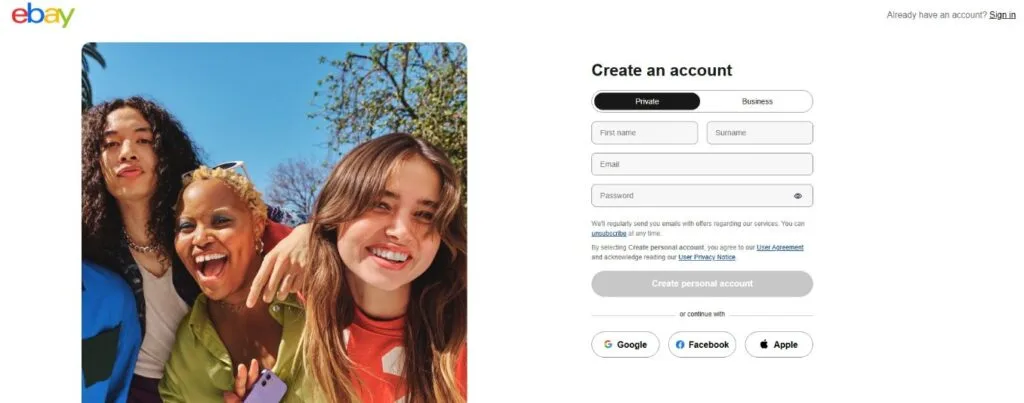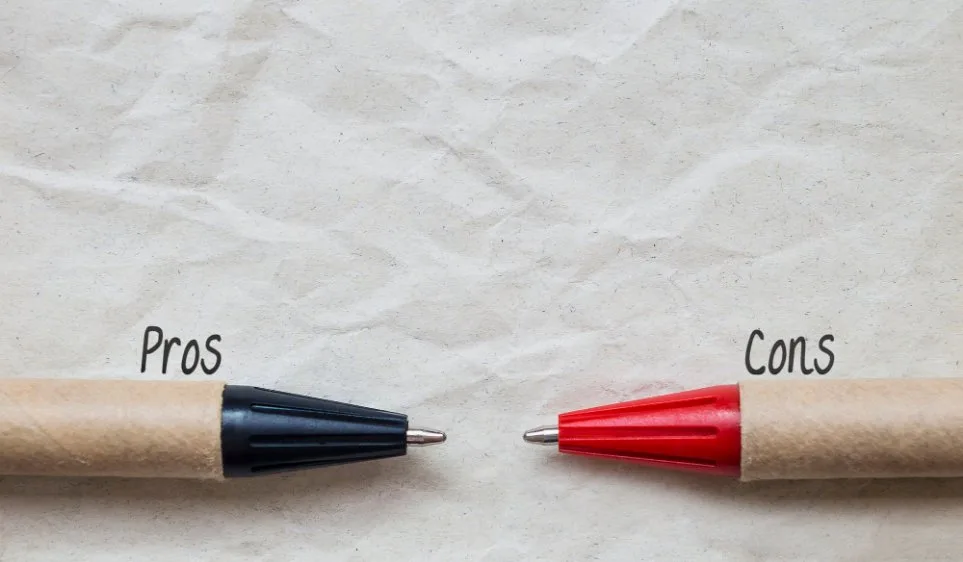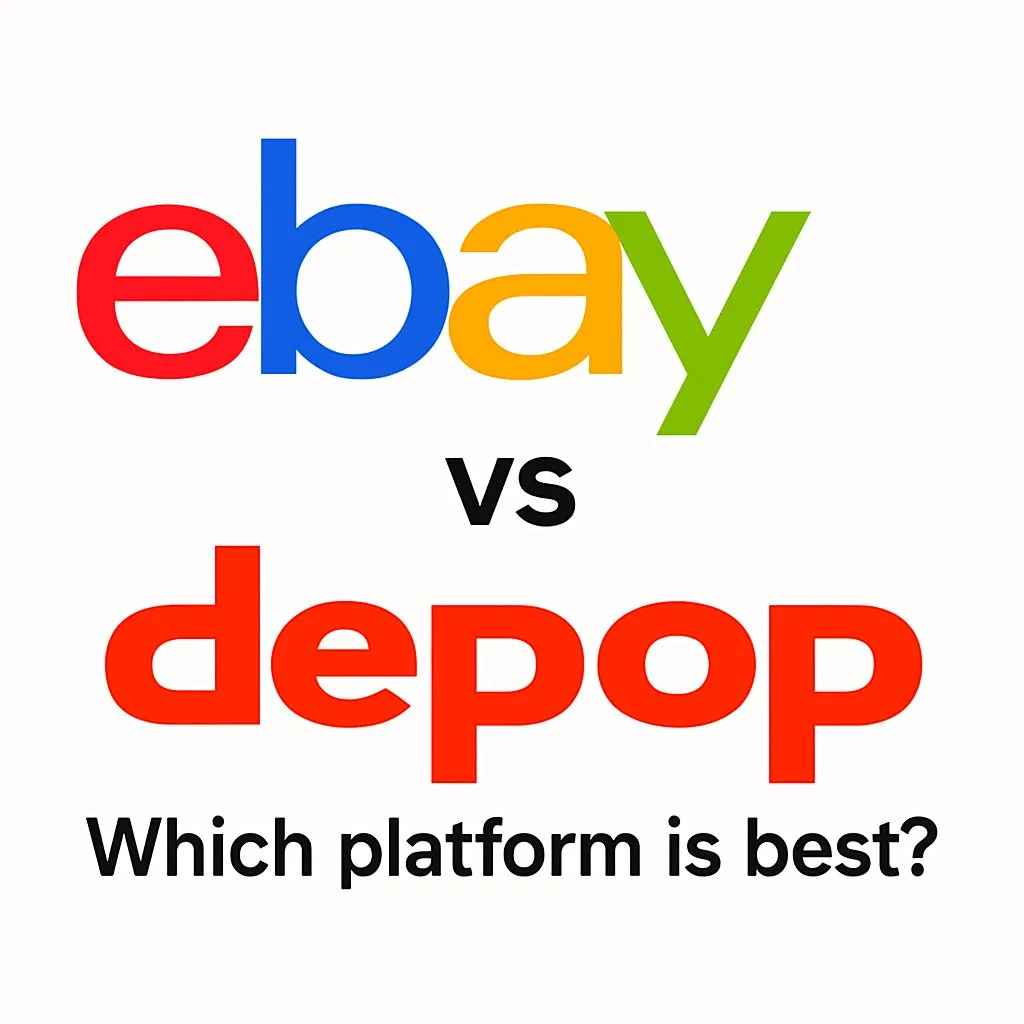Fees, Audiences, and Profit Strategies for Fashion Resellers
Got a closet full of clothes you don’t wear anymore? You’re not alone. Selling clothes online has become a popular way to make extra cash while clearing out space. But picking the right platform matters more than you might think.
Both Depop and eBay let you sell clothes online, but they work differently and attract different buyers. If you want to reach trendy younger shoppers with unique fashion pieces, Depop might be your best bet. On the other hand, eBay works better if you’re selling a wider range of clothing to buyers of all ages.
This guide breaks down everything you need to know about selling on both platforms, including real numbers, fee breakdowns, and strategies that actually work in 2025.
The global secondhand clothing market in 2025, projected to reach $350 billion by 2027
Table of Contents
- Market Insights: The Growing Secondhand Economy
- Platform Overview: Depop vs eBay
- Account Setup and Listing Your Items
- Audience and Buyer Demographics
- Fee Structures and Costs
- Shipping, Payments, and Transaction Management
- What Should Be Sold on Both Platforms
- Advantages and Disadvantages
- Is Depop Owned by eBay?
- Cross-Posting Strategy for Maximum Reach
- Resale Opportunities and Circular Economy
- User Experience and Platform Features
- Alternative Marketplaces
- Timing and Strategy for Success
- Which Platform is Better?
- Frequently Asked Questions
Market Insights: The Growing Secondhand Economy
The secondhand clothing market isn’t just growing; it’s exploding. The global market hit $177 billion in 2025 and experts predict it’ll reach $350 billion by 2027. That’s massive growth in just two years.
American shoppers bought over 5 billion secondhand items in 2024, with clothing making up 40% of those purchases. According to ThredUp’s 2025 Resale Report, the US secondhand apparel market grew 14% in 2024, outpacing the broader retail clothing market by 5 times. This shift shows how attitudes toward sustainable fashion and budget-friendly shopping have changed, especially among millennials and Gen Z (they now represent 65% of secondhand buyers).
Regional preferences vary quite a bit across the country. East Coast buyers tend to go for designer and business attire, while West Coast shoppers lean toward casual and vintage pieces. Midwest consumers often look for practical, everyday clothing at competitive prices. Understanding these regional trends helps you price and market your items better.
Platform Overview: Depop vs eBay
Before diving into the details, let’s look at what makes each platform unique.
What is Depop?
Depop is a mobile-first app that focuses on fashion, especially trendy and vintage clothing. Think of it as Instagram meets a thrift store. The main user base skews young, with most buyers and sellers between 16 and 30 years old.
The app looks and feels like a social network. You can post photos, add descriptions, use hashtags, and set prices. Buyers can like, comment, and follow your shop, making it easy to build a community around your style.
Depop works best for selling one-of-a-kind pieces, vintage clothing, or clothes that match current trends. Listing is free, but you pay a fee when an item sells. The visual layout and direct messaging make it easy to interact with buyers.
What is eBay?
eBay is a long-standing online marketplace known for its huge selection. It attracts millions of buyers worldwide looking for everything from rare collectibles to everyday clothing.
You can list items as auctions or fixed-price sales. eBay supports both single items and bulk lots, which helps if you want to sell large amounts of cotton clothing or mixed inventory. The platform’s audience varies more in age and interests than Depop.
eBay charges fees mostly when your items sell. The listing process offers more options for shipping, pricing, and returns, which might work better if you have many different things to sell. eBay’s search and filtering help buyers find exactly what they want.
Growth of Online Marketplaces for Secondhand Clothing
The market for secondhand clothing online keeps growing. More people choose to buy and sell used clothes because it’s more affordable and better for the environment.
Platforms like Depop and eBay make it easy to reach buyers across the country or even around the world. The rise of mobile apps and social shopping trends means shoppers are more interested in unique and sustainable fashion.
Online marketplaces now offer features like secure payments, seller protection, and easy shipping to support both new and experienced sellers. This growth creates more opportunities whether you want to clear out your closet or start a small used clothing business.
Account Setup and Listing Your Items

Getting started with selling clothes online involves setting up accounts and listing your items the right way. Both platforms offer easy signup processes and tools to help you manage your listings.
Creating an Account on Depop
To join Depop, start by downloading the app or visiting the website. You need to provide your email, create a username, and make a password. You can also sign up using your Google or Facebook account.
Depop asks for basic information like your name and address. This is needed so the sale and shipping process goes smoothly. You’ll also need to link your PayPal account to receive payments.
Once registered, setting up your profile helps build trust with buyers. Add a clear photo and write a short bio about yourself or your shop. The whole setup process usually takes just a few minutes. For more guidance, check the Depop Help Center.
Creating an Account on eBay
eBay also lets you sign up using their app or website. You need an email, password, and some personal details like your address. You can sign up with a Google or Apple account too.
For selling, eBay asks for more information to set up payment options. Linking a bank account is usually required. If you sell a lot, you might need to provide extra verification.
You get a seller profile on eBay. Fill out your information carefully to look reliable to buyers. Add a professional profile picture if possible. The setup is straightforward and usually quick for new users.
Listing Clothes: Process and Best Practices
On Depop, listing an item is simple. Tap the “Sell” button, take up to four photos of your item, and enter details such as brand, size, condition, and price. Make sure photos are clear and show the front, back, and any flaws. Depop doesn’t let you edit or crop photos directly in the app, so prepare your pictures before uploading.
Write a short but clear description. Include keywords that buyers might search for, like the brand name and size. List items in the correct category for better visibility.
eBay’s process is similar but offers more options. You can add up to 12 photos and use built-in photo editing tools. Write detailed titles and descriptions with keywords, mention any flaws, and choose the right category. eBay allows you to set auction or fixed prices and offers shipping calculators.
Whether you use Depop or eBay, focus on clear photos, honest descriptions, and competitive pricing to attract buyers.
Which Platform Has Better Listing Options?
eBay wins when it comes to listing flexibility. You get 12 photos versus Depop’s 4, built-in editing tools, detailed shipping calculators, and the choice between auction or fixed-price formats. eBay also offers promoted listings and gallery features for increased visibility.
Depop’s strength lies in simplicity and speed. You can list an item in under two minutes, and the streamlined process works well for casual sellers. The social media style interface makes it easy to cross-post to Instagram or other platforms.
For sellers with diverse inventory or those wanting maximum control, eBay provides better options. For quick, social-style selling of trendy items, Depop’s simplified approach often works better.
AI-Powered Listing Tools
eBay offers several AI-driven tools to help sellers. One is the listing tool that suggests product titles, descriptions, and categories based on your photos. This speeds up the listing process and can improve search visibility.
Recent updates include an AI-powered background removal tool and automatic defect detection that can spot stains, holes, or wear patterns in your photos. These features help create more professional listings and reduce buyer disputes.
Depop’s features are simpler, but AI is used to recommend your listings to interested buyers. The app’s search and discovery tools help your items show up in more feeds. Depop also uses data to suggest hashtags and popular search terms.
Audience and Buyer Demographics

Understanding who shops on each platform helps you sell smarter. The buyer demographics are quite different between Depop and eBay.
Gen Z and Younger Shoppers on Depop
Depop is popular with people in their teens and twenties. Many users are from Gen Z, drawn in by trends, community, and a focus on personal style.
You’ll find that Depop’s design feels similar to social media apps. Shoppers can follow sellers, like posts, and even send messages to negotiate prices. This makes it easy to connect with buyers who care about how clothes are styled or presented.
Trendy items and vintage clothing often sell well here. Depop buyers look for one-of-a-kind pieces, Y2K fashion, 90s styles, and streetwear. If you want to reach a younger crowd that values unique fashion, Depop is a good choice.
Research shows that 73% of Depop users are under 26, and they typically spend 30% more time browsing than traditional e-commerce shoppers. This engaged audience often makes impulse purchases based on aesthetic appeal and trend relevance.
Diverse Buyers on eBay
eBay has a much broader audience. Buyers range from teenagers to older adults, and from casual shoppers to serious collectors. This means you can sell to people with all kinds of preferences.
You can list anything from fast fashion to high-end designer or everyday basics. eBay’s global reach allows you to find buyers from different countries and backgrounds.
eBay shoppers are often searching for deals, specific brands, or hard-to-find vintage items. Some buyers use eBay to find discontinued pieces or bargain prices. The platform attracts 87 million active buyers monthly, with the largest demographic being adults aged 35-54 who have higher disposable income.
Types of Clothing and Vintage Items in Demand
The types of clothing that sell well depend on the platform and current market trends.
On Depop, demand is highest for retro and vintage clothing, bold prints, and branded streetwear. The focus is on unique or curated pieces that help buyers express themselves. Popular categories include vintage denim jackets, graphic tees, and accessories from the 80s, 90s, and early 2000s.
Current trending items include cottage core dresses, chunky knit sweaters, vintage band tees, and anything related to popular TV shows or movies. Sustainable fashion brands and upcycled pieces also perform well.
eBay supports sales of both vintage and modern clothes, but vintage items can do especially well if they’re rare or collectible. Listing details, clear photos, and accurate condition info matter here. Buyers are also interested in large lots, single standout pieces, or even new clothing from known brands.
Athletic wear from premium brands like Lululemon, vintage leather jackets, and designer handbags consistently perform well across both platforms.
What Sells the Most on Both Platforms?
Top Depop Categories
- Vintage graphic tees and band merch
- Y2K and early 2000s fashion
- Streetwear and sneakers
- Handmade jewelry and accessories
- Sustainable fashion brands
Top eBay Categories
- Designer handbags and accessories
- Athletic and activewear
- Vintage denim and leather goods
- Business and professional attire
- Plus-size clothing options
Seasonal trends significantly impact sales. Back-to-school season (July-September) drives demand for casual wear on both platforms. Holiday party season increases formal wear sales, while spring cleaning season (March-May) sees the highest seller activity.
| Platform | Most Popular Buyers | Clothing in Demand |
|---|---|---|
| Depop | Gen Z, young adults (16-30) | Vintage, retro, streetwear, trendy |
| eBay | All ages, global buyers (35-54) | Vintage, modern, collectibles, new |
Fee Structures and Costs

Each platform charges different fees and uses its own system for handling selling costs. Knowing exactly what you’ll pay before listing your items helps you set prices and expectations.
Is It Cheaper to Sell on Depop?
The answer depends on your selling volume and item prices. For individual items under $50, Depop often proves more cost-effective due to its simpler fee structure and unlimited free listings. However, for higher-value items or bulk sellers, eBay’s managed payments system can sometimes result in lower overall costs.
Let’s break down the real costs with specific examples:
Example 1: $25 vintage tee + $5 shipping
- Depop: 10% fee = $3.00, PayPal fee = $1.17, Total fees: $4.17
- eBay: 13.25% fee = $3.98, order fee = $0.30, Total fees: $4.28
Example 2: $100 designer jacket + $10 shipping
- Depop: 10% fee = $11.00, PayPal fee = $3.49, Total fees: $14.49
- eBay: 13.25% fee = $14.58, order fee = $0.30, Total fees: $14.88
For most clothing items, the difference is minimal, but Depop edges out slightly for lower-priced items while eBay becomes competitive for higher-value pieces.
Want to compare fees for your specific items? Use our free Depop vs eBay Fee Calculator to see exactly which platform saves you more money.
Depop Seller Fees
Depop keeps its fee structure simple. You only pay a fee when an item sells. The standard seller fee is 10% of the item’s total sale price, including shipping costs. For example, if your item sells for $20 plus $5 shipping, Depop takes $2.50.
Depop doesn’t charge any listing fee or monthly fee. However, you still need to pay a PayPal transaction fee. In most cases, PayPal charges around 2.9% + $0.30 per transaction. Depop includes the PayPal fee in the payment process, so you see all deductions in your final payout.
There are no hidden fees or premium account requirements. You can list as many items as you want without extra costs.
eBay Seller Fees
eBay uses a more detailed fee structure than Depop. eBay sellers pay a final value fee on each sale, which is a percentage of the total amount paid by the buyer, including the cost of the item, shipping, and sometimes sales tax.
For most fashion items, the final value fee on eBay is 13.25% of the total sale amount, plus a fixed fee of $0.30 per order. This means if you sell a shirt for $30 plus $5 shipping, eBay takes about $4.63 plus $0.30.
eBay gives you up to 250 free listings per month. After that, you pay $0.35 per listing. eBay also has optional fees for premium listings, promoted listings, and added features like bold titles.
Recent Fee Changes in 2025
The resale market has seen significant fee structure changes recently. eBay UK eliminated seller fees entirely for clothing, charging buyers instead. Mercari and some other platforms have followed similar models.
While US eBay sellers still pay the 13.25% fee, these changes show the industry is shifting. Depop continues with its 10% seller fee model, which has remained consistent.
Comparison of Final Value Fee and Selling Fees
| Platform | Selling Fee | Listing Fee | Per Order Fee | PayPal Fee | Free Listings |
|---|---|---|---|---|---|
| Depop | 10% | $0 | $0 | 2.9% + $0.30 | Unlimited |
| eBay | 13.25% | $0 (up to 250) | $0.30 | 2.9% + $0.30 | 250/month |
Tax Implications for Sellers
Both platforms now send 1099-K tax forms to sellers who exceed $600 in gross sales annually. This change took effect in 2023, so you need to track your income and expenses more carefully.
Important Tax Considerations
- Keep records of all selling expenses (shipping supplies, listing fees, cost of goods)
- Track mileage for post office trips
- Consider whether you’re selling as a hobby or business (affects tax treatment)
- Some states require sales tax collection on certain transactions
Consult with a tax professional if you’re earning significant income from either platform.
Free Fashion Selling Options
Depop doesn’t offer a completely free way to sell fashion items since there is always a 10% fee on sales. There are no listing or premium account fees, but you still pay when you make a successful sale.
eBay lets you list up to 250 items per month for free in most clothes and fashion categories. However, you still pay the final value fee and the $0.30 per order fee even if your listings are free.
For sellers looking to avoid all fees, neither Depop nor eBay fully fits that need. Some local apps and social media allow you to sell without direct selling fees, but they come with their own trade-offs. For detailed information on eBay’s current fee structure, visit the eBay Seller Center.
Free listing limits and simple selling fees are the main ways these platforms support lower up-front costs for fashion resellers.
Shipping, Payments, and Transaction Management

When you sell clothes online, handling shipping, payments, and disputes matters as much as listing your items. Depop and eBay take different approaches, so your experience with fees, payment options, and problem-solving can change depending on the platform you use.
Shipping Methods and Costs
On eBay, you can select from a wide range of shipping carriers like USPS, FedEx, and UPS. You control shipping costs, offer free or flat rate shipping, and print shipping labels through eBay itself. eBay also lets buyers choose their preferred shipping speed and shows estimated delivery dates at checkout.
Recent data shows that eBay sellers who offer free shipping see 20% more visibility in search results. The platform’s calculated shipping tool automatically adjusts rates based on buyer location, which can increase conversion rates by up to 15%.
Depop has a more streamlined setup. You can use Depop’s built-in shipping service, which provides prepaid labels for USPS. Shipping costs are usually set and depend on the size and weight of your package. Alternatively, you can ship items yourself and set your own rates, but many sellers use Depop’s labels for convenience.
Regional shipping insights: East Coast to West Coast shipping typically takes 3-5 business days and costs $8-12 for standard clothing items. Priority Mail often provides better value for items over $30 due to included insurance and faster delivery times.
Keep in mind, buyers pay for shipping on both platforms unless you choose to offer it for free. Fast, trackable shipping can improve your ratings and lead to more sales.
Payment Options: PayPal and Alternatives
eBay supports a variety of payment options through its Managed Payments system. Buyers can pay using PayPal, credit and debit cards, Apple Pay, Google Pay, and more. You get paid directly to your bank account, and eBay handles payment processing, making it simple and secure.
Depop mainly relies on PayPal for payments. Buyers pay through PayPal, and the money is deposited to your PayPal account once the sale is complete. Some regions also support in-app card payments, but PayPal is the primary method. You need to set up a PayPal account to sell on Depop.
All payments on both platforms are processed securely, but eBay offers more payment flexibility than Depop. Fees are deducted automatically from your earnings on both sites.
Payment Processing Times
- Depop: 1-3 business days to PayPal, then 1-2 days to bank
- eBay: Next business day to bank account (managed payments)
How Do Returns and Refunds Work on Both Platforms?
eBay Return Policy: eBay gives you the option to set your own return policy. You can allow returns within a specific number of days (14, 30, or 60 days) or mark sales as final. If a buyer opens a dispute, eBay’s Resolution Center steps in to help both sides resolve the issue.
Key points about eBay returns:
- You can require buyers to pay return shipping
- Items must be returned in original condition
- eBay typically sides with buyers in “item not as described” cases
- Sellers can offer partial refunds for minor issues
Depop Return Policy: On Depop, all sales are considered final unless the item is not as described or damaged during shipping. Buyers can open a dispute through PayPal if there’s a problem. Depop’s support team may step in if needed, but PayPal’s buyer protection rules often apply.
Depop return considerations:
- No returns for “changed mind” or sizing issues
- Sellers must respond to disputes within 7 days
- Photo evidence is crucial for both parties
- PayPal typically holds funds during active disputes
Best Practices for Managing Returns and Disputes
Return Management Checklist
What Should Be Sold on Both Platforms?

Understanding what performs best on each platform can significantly impact your selling success. While there’s some overlap, each platform has distinct strengths based on their audience and culture.
Items That Excel on Depop
Vintage and Y2K Fashion (Peak Performance)
- 1990s and early 2000s pieces
- Vintage band tees and concert merch
- Retro athletic wear and windbreakers
- Chunky platform shoes and accessories
Trendy and Instagram-Worthy Items
- Aesthetic clothing that photographs well
- Pieces featured by fashion influencers
- Sustainable and eco-friendly brands
- Handmade and upcycled items
Streetwear and Urban Fashion
- Limited edition sneakers
- Graphic hoodies and sweatshirts
- Designer collaborations
- Independent brand pieces
Items That Excel on eBay
Designer and Luxury Goods
- Authenticated designer handbags
- High-end department store brands
- Vintage luxury items with documentation
- Complete designer outfits or sets
Practical and Professional Wear
- Business suits and blazers
- Everyday basics in common sizes
- Maternity and plus-size clothing
- Seasonal items in bulk lots
Collectible and Rare Items
- Discontinued designer pieces
- Vintage sporting goods and jerseys
- Fashion from specific decades with collector appeal
- Costume and theatrical clothing
Cross-Platform Success Items
Some items perform well on both platforms, giving you the flexibility to choose based on convenience:
Premium Athletic Wear
- Lululemon, Nike, Adidas pieces
- Vintage athletic jerseys
- Athleisure and activewear sets
Classic Denim
- Vintage Levi’s in all sizes
- Premium denim brands
- Unique or distressed pieces
Quality Outerwear
- Leather jackets (vintage and modern)
- Wool coats and peacoats
- Designer rain and snow gear
Brand Name Accessories
- Designer handbags and wallets
- Vintage scarves and belts
- Statement jewelry pieces
Advantages and Disadvantages of Both Platforms

Depop Advantages
- Quick listing process (under 2 minutes)
- Unlimited free listings
- Social media integration
- Built-in photo filters and editing
- High buyer engagement rates
- Direct communication with buyers
- Lower barrier to entry
- No monthly fees
- Straightforward fee structure
- Mobile-optimized experience
Depop Disadvantages
- Heavy reliance on PayPal
- Fewer buyer payment methods
- Only 4 photos per listing
- No auction format
- Limited description space
- Fewer search filter options
- Primarily younger demographic
- Limited appeal for professional items
- Trend-dependent sales patterns
eBay Advantages
- Advanced listing options (12 photos)
- Multiple selling formats (auction and fixed price)
- Robust search and filtering system
- Professional seller tools and analytics
- Multiple payment methods accepted
- Fast direct bank transfers
- International payment support
- Massive international audience
- Comprehensive dispute resolution
- Advanced security measures
eBay Disadvantages
- Multiple fee types
- Higher overall selling fees
- Additional charges for premium features
- Complex listing process for beginners
- Many options can overwhelm new sellers
- Detailed shipping calculations required
- Millions of similar listings
- Price-driven buyer behavior
- Difficult to stand out without promotions
- Algorithm favors established sellers
Is Depop Owned by eBay?

This common question deserves clarification. Depop is not owned by eBay. Depop was founded in 2011 by Simon Beckerman and remained independent until August 2021, when it was acquired by Etsy for approximately $1.6 billion.
The confusion likely stems from both being major online marketplaces, but they operate as completely separate companies with different business models, fee structures, and target audiences.
Ownership Timeline
- 2011-2021: Independent company
- 2021-Present: Subsidiary of Etsy, Inc.
This acquisition has allowed Depop to maintain its unique social selling model while benefiting from Etsy’s infrastructure and experience in marketplace operations.
Cross-Posting Strategy for Maximum Reach
One of the smartest strategies for serious resellers is cross-posting, which means listing the same items on multiple platforms at once. This approach can dramatically increase your sales and reach different buyer audiences.
Why Cross-Posting Works
Users who list on 3 or more marketplaces have a sell-through rate 180% higher than users who list on fewer marketplaces. That’s a massive difference that can turn a side hustle into a real income stream.
Cross-posting lets you:
- Reach both Depop’s young, trendy audience and eBay’s broader demographic
- Reduce risk if one platform has slow sales periods
- Test which platform works better for specific items
- Maximize visibility for your inventory
Top Cross-Posting Tools for 2025
Several tools make cross-posting easier by letting you create one listing and post it to multiple platforms automatically:
Vendoo
Best for: Serious resellers with high volume
Platforms: eBay, Depop, Poshmark, Mercari, and 10+ others
Key Features: Auto-delisting when items sell, bulk relisting, AI listing enhancement, detailed analytics
Pricing: Starts at $29.99/month
Crosslist
Best for: Beginner to intermediate sellers
Platforms: eBay, Depop, Etsy, Poshmark, Mercari, and 11 total
Key Features: Single form for all platforms, AI listing generation, background auto-posting
Pricing: Starts at $29.99/month
List Perfectly
Best for: Budget-conscious sellers
Platforms: eBay, Depop, Poshmark, Mercari, Etsy, and more
Key Features: Bulk listing creation, inventory tracking, automatic cross-posting
Pricing: Free tier available, paid plans start at $9.99/month
Cross-Posting Best Practices
Cross-Posting Success Checklist
Avoiding Double-Selling
The biggest risk with cross-posting is selling the same item on two platforms at once. Here’s how to prevent it:
- Use tools with automatic delisting features (Vendoo, Crosslist, List Perfectly all offer this)
- Check all platforms immediately when you make a sale
- Set up notifications on your phone for all selling platforms
- Keep a simple spreadsheet tracking where each item is listed
Resale Opportunities and Circular Economy Impact

Selling your clothes on Depop or eBay does more than just make extra money. Both platforms offer ways to reduce waste, keep clothing out of landfills, and boost the movement for more eco-friendly fashion.
Promoting the Circular Economy
When you sell unwanted clothes online, you support the circular economy. This system helps products stay in use for longer by encouraging repair, reuse, and resale.
On Depop, many users buy and sell items that might otherwise be thrown away. eBay also extends the life of clothes by linking buyers and sellers across the globe.
By choosing resale, you help cut down on clothing waste. Each item you sell moves one step closer to a cycle that keeps resources in use and out of the trash.
ROI Analysis for Sellers
Understanding your potential return on investment helps set realistic expectations:
| Item Type | Average ROI | Best Platform |
|---|---|---|
| Vintage designer pieces | 300-500% markup | Both (Depop for trendy, eBay for classic) |
| Trendy fast fashion | 50-150% markup | Depop |
| Athletic wear | 200-400% markup | Both |
| Everyday basics | 25-100% markup | eBay |
Time Investment Considerations
- Photography and listing: 10-15 minutes per item
- Customer service: 2-5 minutes per sale
- Packaging and shipping: 5-10 minutes per sale
- Total time per sale: 17-30 minutes
Break-even calculations: Most sellers need to sell items for at least 3x their original price to account for fees, time, and shipping materials.
Calculate your exact profit margins with our Resale Profit Margin Calculator that factors in all costs including fees, shipping, and your time investment.
Decluttering and Cash In Pockets
Decluttering your wardrobe has a double benefit. You clear space at home and can earn extra cash by selling items you no longer use.
On eBay, selling old clothes can reach a wide audience, so even worn or out-of-style items might find a new owner. Depop often appeals to younger shoppers looking for unique or vintage fashion.
Many sellers use these platforms to turn excess clothing into spending money. This process is direct: price your items, ship them out, and receive payment in your account, often within days.
Track all your sales and monitor your monthly performance with our Monthly Resale Earnings Tracker to see your total revenue, expenses, and profit at a glance.
Seasonal decluttering strategy: Spring cleaning season (March-May) sees 40% higher seller activity, while back-to-school season (July-September) drives the strongest buyer demand.
Resale Trends in Fashion
Secondhand fashion is growing fast. Current market data shows:
- 73% of Gen Z shoppers buy secondhand clothing
- Resale market growing 11x faster than traditional retail
- Average consumer owns 5 pieces they’ve never worn
- Sustainability is the top purchase motivator for 67% of young shoppers
Sustainable Online Selling Practices
Selling online helps reduce waste, but there are ways to make it even greener. Using recycled packaging, limiting extra shipping materials, and choosing local buyers when possible can all lower your environmental impact.
Packaging Tips for Sustainability
- Reuse shipping boxes and envelopes
- Use biodegradable packing materials
- Skip unnecessary packaging elements
- Include a note about your sustainable practices
Comparing User Experience and Platform Features

Depop and eBay have different strengths and features when it comes to selling clothes. Each platform offers unique tools, communities, and ways to list your items, so it’s important to know how they compare.
App Interface and User Friendliness
Depop is designed to look and feel like a social media app. The main feed uses large images and an easy-to-navigate layout, so you can scroll, tap, and discover new listings quickly. Listing an item is straightforward since you fill in basic info, upload photos, and set the price in just a few steps.
eBay has a more traditional marketplace layout. The app and website focus heavily on search tools, filters, and sorting options. You have more choices for describing, pricing, and setting up your item. Some users say eBay can feel more complicated, especially if you’re not used to selling.
In general, you’ll likely find it faster to create a listing on Depop, while eBay requires more details but offers more settings and long-term selling options.
Customer Support and Community
Depop offers in-app customer support with responses to common questions. The community is smaller and more focused on fashion and reselling clothes. If you need help, it’s often easy to find advice on selling, shipping, and handling returns from other users as well as Depop staff.
Response times average 24-48 hours for standard inquiries, with live chat available during peak hours. The community aspect includes seller meetups in major cities and collaboration opportunities with fashion brands.
eBay has a larger support system with chat, help centers, and phone hotlines. Since eBay handles a wide range of items beyond clothing, you may find broader support resources. The seller forums are active, though not always specific to clothing.
eBay’s support operates 24/7 with multiple contact methods and typically faster response times for urgent issues. However, the vast amount of information can sometimes make finding specific answers more challenging.
Social Selling and Engagement
Depop is built around social selling features. You can follow sellers, like items, send messages, and leave public feedback similar to social media apps. Many users build their own brand, create styled posts, and connect with buyers through comments or direct messages.
Advanced social features include:
- Stories and highlights for showcasing inventory
- Collaboration tools for influencer partnerships
- Trend tracking and hashtag analytics
- Community challenges and events
eBay mostly relies on standard listing and buying systems. Messaging is for negotiations or questions, and user profiles focus on ratings and sales history rather than community interaction. There’s less emphasis on personal branding or social networking.
However, eBay offers:
- Professional seller storefronts
- Detailed analytics and performance metrics
- Advanced promotional tools
- Business seller benefits and recognition programs
If connecting directly with buyers or building a reselling brand is important for you, Depop’s social features make the experience feel more interactive and engaging.
Alternative Online Marketplaces for Selling Clothes

There are several online platforms besides Depop and eBay that make it easy to sell used, vintage, or designer clothing. Each marketplace has its own features, payment methods, and types of buyers, so you can find the best fit for what you want to sell.
Overview of Top Alternatives
If you want to reach different types of buyers, you can use platforms like Poshmark, Vinted, thredUP, Etsy, Grailed, and Vestiaire Collective. Each of these offers tools for listing your items and connecting with shoppers.
Etsy and Handmade/Vintage Sales
Etsy is a top choice if you sell vintage clothes (over 20 years old) or handmade items. The focus is on unique, creative, or rare pieces. You set up a shop, add product photos, and write detailed descriptions. Etsy charges a small listing fee plus a percentage of each sale.
You can connect with buyers who are looking for something special or one-of-a-kind. Etsy provides seller protections like secure payment and customer support. Because the audience expects originality, mass-produced or fast-fashion brands don’t sell as well here.
Vinted, Poshmark, and thredUP Comparison
Vinted, Poshmark, and thredUP are broad resale marketplaces, each with strengths and differences. Vinted is popular for low commission fees and free listings. It suits mid-range and fast fashion, letting you keep more profit.
Poshmark has a strong community feel, with users able to like, share, and comment. It’s easy to use especially if you want to sell from your closet. Poshmark charges a flat fee for sales under $15 and takes a 20% cut for sales over that.
Recent data shows Poshmark sellers who participate in “Posh Parties” (themed virtual shopping events) see 35% higher engagement rates.
thredUP is more of a consignment store online. You send in your clothes, and their team photographs and lists them for you. Payment is lower since thredUP handles most of the work but it’s a “hands-off” way to declutter.
Specialty Marketplaces: Grailed, Vestiaire Collective, Rebag
If you have designer, luxury, or streetwear pieces, Grailed, Vestiaire Collective, and Rebag are worth considering. Grailed is known for streetwear, sneakers, and high-demand men’s fashion. You list the item yourself, set the price, and buyers can make offers.
Market data shows that rare sneakers and limited-edition streetwear can sell for 200-800% above retail value on Grailed, making it particularly attractive for sellers with exclusive pieces.
Vestiaire Collective focuses on authenticated luxury and designer brands, including both men’s and women’s apparel. Items often go through an authenticity check before the sale is complete, which builds trust with buyers but adds some shipping time and commission cost.
Rebag specializes in designer bags and accessories. The platform offers authentication and instant buy options. You get a quote for luxury bags upfront, and payments are processed quickly after approval.
| Platform | Best For | Fees | Special Features |
|---|---|---|---|
| Vinted | Fast fashion, everyday | Low commission | Free listings |
| Poshmark | Mid-range, community | 20% commission | Social selling |
| thredUP | Convenience | Varies, lower | Ship items in bulk |
| Etsy | Vintage, handmade | Listing + % sale | Focus on unique items |
| Grailed | Streetwear, men’s style | Small % sale | Offers/negotiations |
| Vestiaire Collective | Designer, luxury | Higher commission | Authentication |
| Rebag | Designer accessories | Varies | Instant buy, quotes |
Regional and Local Selling Options
Facebook Marketplace has become increasingly popular for local clothing sales, particularly for parents selling children’s clothes in bulk lots. The ability to avoid shipping costs and meet buyers in person appeals to many sellers.
Mercari offers a middle ground between Depop’s simplicity and eBay’s complexity, with growing popularity in suburban markets. The platform’s $2 flat fee for sales under $10 makes it attractive for lower-priced items.
Local consignment stores and pop-up markets provide alternatives to online selling, especially for sellers who prefer face-to-face transactions or want to avoid shipping logistics.
Timing and Strategy for Maximum Success

When you list your items and how you plan your selling strategy can make a huge difference in your success. Here’s what works best for each platform.
Best Times to List and Sell
Optimal listing times vary by platform:
Depop Best Times
- Best days: Thursday-Sunday evenings
- Best hours: 6-9 PM
- Why: Younger users are most active during these times
eBay Best Times
- Auctions: Sunday evenings
- Fixed-price: Wednesday mornings
- Why: Broader audience shopping patterns
Seasonal Selling Calendar
| Season/Event | When | What to Sell | Strategy |
|---|---|---|---|
| Spring Cleaning | March-May | All categories | Highest seller activity, moderate buyer demand. Price competitively. |
| Back-to-School | July-September | Casual wear, basics | Peak buyer demand. Stock up on trendy pieces for Depop. |
| Holiday Season | November-December | Formal wear, accessories | Strong demand for party outfits and gift items. |
| New Year | January | Activewear, organizational items | People setting goals. Focus on fitness and fresh start clothing. |
Building a Sustainable Selling Business
Inventory Sourcing Strategies
- Thrift store partnerships and bulk buying
- Estate sale and garage sale sourcing
- Wholesale lot purchases
- Trade-ins and customer referrals
Scaling Your Operation
Growth Checklist
Photography and Listing Optimization
Quality photos make a huge difference in selling success on both platforms. Here’s what works:
Photography Best Practices
- Natural lighting: Take photos near a window during daylight hours
- Plain background: White or neutral walls work best
- Multiple angles: Front, back, detail shots of any flaws
- Flat lays vs. modeled: Depop prefers modeled shots, eBay works well with both
- Show scale: Include measurements or wear the item
Pricing Strategies
Setting the right price requires research and strategy:
- Research comparable items: Search for similar items on both platforms to see current prices
- Factor in all costs: Include fees, shipping supplies, and your time
- Price higher on eBay: The audience expects to pay more for convenience and variety
- Price for negotiation on Depop: Buyers often message to bargain
- Use psychological pricing: $19 looks better than $20
Need help determining the right price for your items? Our Resale Pricing Strategy Worksheet provides category-specific recommendations for vintage, designer, streetwear, athletic wear, and everyday basics.
eBay or Depop: Which Platform is Better for Selling Clothes?

The answer depends entirely on your specific situation, items, and goals as a seller. Neither platform is universally “better” – they excel in different areas and serve different markets.
Platform Decision Flowchart
→ Choose Depop
→ Choose eBay
→ Choose Depop
→ Choose eBay
→ Choose Depop
→ Choose eBay
Choose Depop If You:
- Sell trendy, vintage, or unique fashion pieces
- Target younger buyers (16-30 age range)
- Prefer simple, social media-style selling
- Want unlimited free listings
- Sell items typically under $100
- Enjoy building a personal brand and community
- Have time to engage with buyers through comments and messages
- Can take great photos that look Instagram-worthy
Choose eBay If You:
- Sell a wide variety of clothing types and brands
- Want to reach a global, diverse audience
- Need advanced selling tools and options
- Sell higher-value or collectible items
- Prefer detailed analytics and business tools
- Want multiple payment and shipping options
- Have professional or business attire to sell
- Plan to sell in bulk or large quantities
Consider Using Both Platforms If You:
- Have diverse inventory that appeals to different audiences
- Want to maximize your exposure and sales potential
- Can manage the additional time investment
- Want to test which platform works better for your items
- Plan to use cross-posting tools to streamline the process
The most successful clothing resellers often start with one platform to learn the basics, then expand to others as their business grows and they better understand their target market.
Frequently Asked Questions
Which platform pays faster, Depop or eBay?
eBay typically pays faster with their Managed Payments system. You receive funds in your bank account the next business day after a sale. Depop payments go through PayPal first (1-3 business days), then you need to transfer from PayPal to your bank (another 1-2 days), making the total time 2-5 business days.
Can I use the same photos on both Depop and eBay?
Yes, you can use the same photos, but keep in mind that Depop allows only 4 photos per listing while eBay allows up to 12. Depop photos should be more styled and aesthetic (like Instagram), while eBay photos can be more straightforward and detailed. If you’re cross-posting, prepare at least 4 high-quality photos that work for both platforms.
How do I handle returns on each platform?
eBay lets you set your own return policy (14, 30, or 60 days, or no returns). Depop considers all sales final unless the item is not as described or damaged. For both platforms, clear photos and honest descriptions help prevent return requests. Always communicate through the platform’s messaging system if issues arise.
Is cross-posting allowed on Depop and eBay?
Yes, cross-posting is allowed on both platforms. Many successful sellers list the same items on multiple platforms to maximize visibility. Just make sure to remove the listing from all platforms immediately when an item sells to avoid double-selling. Using cross-posting tools with auto-delisting features makes this much easier.
Do I need to collect sales tax?
Both eBay and Depop handle sales tax collection automatically in most US states. The platforms calculate, collect, and remit sales tax on your behalf. However, you should still track your income for federal income tax purposes. Remember, both platforms send 1099-K forms if you exceed $600 in sales annually.
What’s the best way to price vintage items?
Research comparable items on both platforms first. Check completed listings on eBay to see what similar items actually sold for (not just asking prices). On Depop, search for the same brand and style. Price vintage items higher on eBay if they’re rare or collectible. On Depop, price trendy vintage pieces competitively since buyers expect to negotiate. For detailed pricing recommendations, try our pricing strategy worksheet which provides category-specific guidance.
How many items should I list to start seeing sales?
Data shows that users who list more than 20 items per month have a sell-through rate that’s 2x higher than users who list less than 10 items. Start with at least 15-20 items to build momentum. The more you list, the more chances you have to make sales. Consistency matters more than listing everything at once.
Should I offer free shipping?
On eBay, offering free shipping can boost your visibility by 20% in search results. Build the shipping cost into your item price. On Depop, most sellers charge for shipping separately since the younger audience is price-sensitive and prefers to see the base item cost. Test both approaches to see what works for your items.
How do I avoid scams on both platforms?
Always communicate through the platform’s messaging system (never take conversations to text or email). Ship to the address provided by the platform only. Take detailed photos before shipping. Use tracking on all shipments. Don’t accept payment outside the platform. Be wary of buyers asking you to ship before payment clears. Both platforms offer seller protection if you follow their guidelines.
Can I sell handmade or upcycled clothing?
Yes, both platforms allow handmade and upcycled items. Depop has a strong market for unique, upcycled pieces that appeal to eco-conscious Gen Z buyers. eBay allows handmade items but you’ll face more competition. If you focus mainly on handmade items, consider also listing on Etsy for maximum exposure to buyers specifically looking for handcrafted goods.
Conclusion
Both Depop and eBay offer valuable opportunities for selling clothes online, but they serve distinctly different markets and seller needs. Your choice between them should align with your inventory, target audience, and business goals rather than following a one-size-fits-all approach.
Depop excels as a social-first platform that transforms fashion resale into a community-driven experience. Its strength lies in connecting sellers with engaged, trend-conscious buyers who value unique pieces and personal style. The simplified fee structure (10% selling fee), unlimited free listings, and social media integration make it particularly attractive for casual sellers and those building a fashion brand. However, the platform’s reliance on PayPal, limited listing features (only 4 photos), and narrow demographic focus can restrict growth potential for some sellers.
eBay provides a comprehensive marketplace solution with robust tools, global reach, and diverse payment options. Its strength comes from serving varied audiences and supporting everything from quick closet cleanouts to serious resale businesses. The advanced features (12 photos, detailed analytics, professional seller tools) justify the higher fees (13.25% plus $0.30 per order) for many sellers. The trade-off is increased complexity and steeper learning curves that may overwhelm newcomers.
Financial considerations reveal that Depop typically offers better value for items under $50, while eBay becomes more competitive for higher-value pieces. Both platforms require understanding tax implications, with the new $600 1099-K threshold affecting all sellers regardless of platform choice.
Market trends strongly favor both platforms as the secondhand clothing market continues its explosive growth. With resale expanding 11 times faster than traditional retail and younger consumers driving 73% of secondhand purchases, both Depop and eBay are positioned to benefit from this shift toward sustainable fashion consumption.
Regional and seasonal patterns significantly impact success on both platforms. Understanding that East Coast buyers prefer professional wear while West Coast shoppers favor casual pieces, or that back-to-school season drives peak demand while spring brings maximum seller activity, can dramatically improve your results.
Key Takeaways and Recommendations
Start with Platform Alignment
Match your inventory to the platform’s strengths rather than forcing a misfit. Trendy vintage pieces and Y2K fashion perform best on Depop, while designer items and professional wear excel on eBay.
Invest in Quality Presentation
Professional photos and honest descriptions drive sales on both platforms. Take time to create clear, well-lit images that show your items accurately. This reduces returns and builds trust with buyers.
Understand Your Time Investment
Factor the 17-30 minutes per sale into your pricing strategy. Most sellers need to price items at least 3x their cost to account for fees, time, and materials. Track which items give you the best return on your time investment.
Use our profit margin calculator to see your actual hourly rate and determine if your pricing strategy is working.
Stay Informed About Trends
Fashion resale rewards sellers who understand current demand patterns. Follow fashion trends, join seller communities, and pay attention to what’s selling quickly on each platform.
Consider Multi-Platform Selling
Once established, expanding to both platforms can significantly increase exposure and sales. Users who list on 3 or more marketplaces have a 180% higher sell-through rate. Cross-posting tools like Vendoo, Crosslist, or List Perfectly make managing multiple platforms much easier.
Final Recommendations
For beginners: Start with Depop if you’re under 30 and selling trendy items. Start with eBay if you have diverse inventory or are over 30. Master one platform before expanding to others.
For serious resellers: Use both platforms with cross-posting tools. Test items on both to see where they perform better. Focus your energy on the platform that generates more sales for your specific inventory.
For sustainability-focused sellers: Both platforms support the circular economy. Emphasize your sustainable practices in your listings, use eco-friendly packaging, and connect with buyers who share your values.
The secondhand fashion market offers tremendous opportunities for sellers willing to understand their platforms, know their audience, and commit to providing excellent customer experiences. Whether you choose Depop, eBay, or both, success comes from matching your approach to your goals and consistently delivering value to buyers in an increasingly competitive but growing marketplace.
Remember, the best platform is the one where your specific items sell best to your target audience. Don’t be afraid to experiment, track your results, and adjust your strategy based on what actually works for you. The resale market continues to grow, and there’s room for sellers who put in the effort to understand their niche and serve their customers well.
Pick the platform that matches your inventory and goals, take great photos, write honest descriptions, and list your first items today. The secondhand fashion market is waiting for you.



